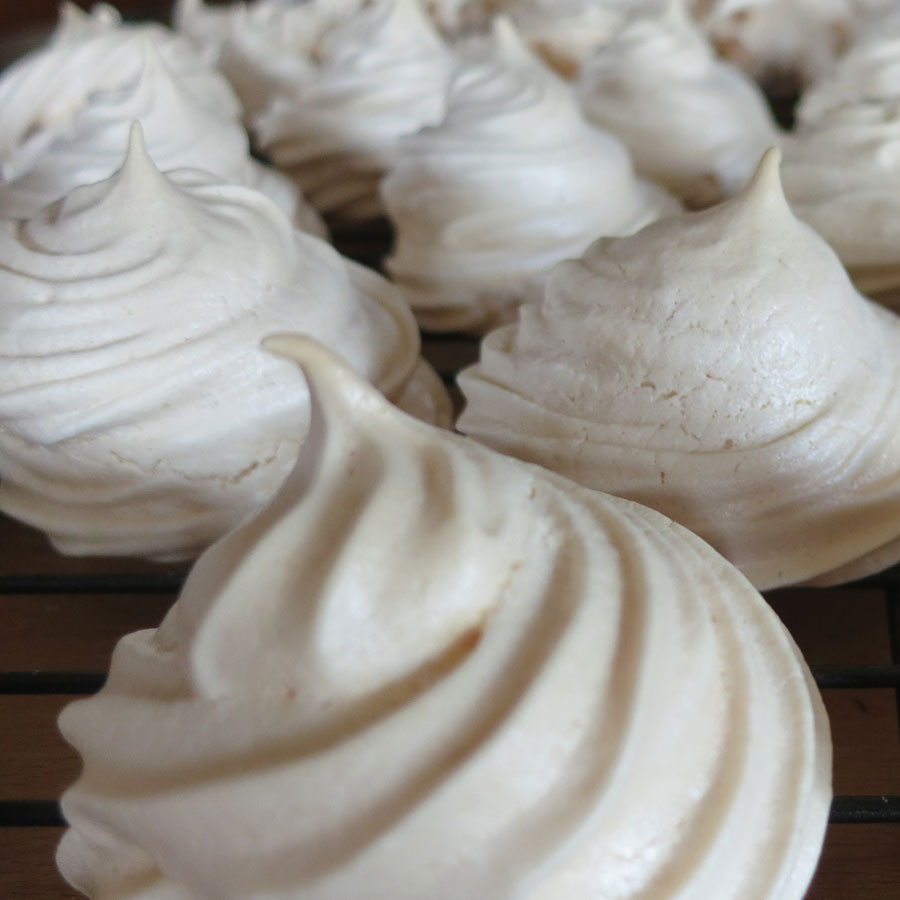Marvelous Meringues
- Advanced
- A Bit Messy
- 15 minutes to put together, 1-2 hours to bake and cool
- Indoor
How do you turn egg whites into a crunchy solid?
Beating egg whites causes an amazing change. When you add sugar and bake them, more changes happen! Go from slimy egg white to fluffy foam to a crunchy solid and delicious cookie while learning about the science behind the marvelous meringue.
You Will Need
2 eggs
1/2 cup sugar
1/2 teaspoon vanilla extract
1/3 cup mini chocolate chips
Mixing Bowl
Electric Mixer
Timer
Measuring Cups and Spoons
Spatula or Wooden Spoon
2 Spoons
Baking Sheet (either greased or lined with parchment paper)
Oven
NOTE: Meringue must be fully cooked to avoid the risk of salmonella contamination.
Directions
- Preheat the oven to 250°
- Ask your child to make a few observations about the ingredients. What do they notice?
- Show your child how to carefully separate the yolks from each egg, allowing just the whites to fall into your mixing bowl. (An egg separator helps this go easily, but if you don’t have one, carefully pass the yolk back and forth between the two halves of the broken shell until all the white has fallen into the bowl.)
- Ask your child to describe what they see in the bowl.
- Set a timer for 1 minute. (You can have your child watch the timer or beat the egg whites in the next step, depending on their skill level.)
- Use the electric mixer to beat the egg whites for 1 minute, or until the eggs begin to get foamy.
- Ask your child to describe the mixture now - how has it changed?
- Now, slowly add the sugar and vanilla while continuing to beat the egg whites. Beat until they begin to form soft peaks.
- Ask your child to describe the mixture now - how has it changed?
- Be careful! If you over-whip the mixture, it will split into runny liquid and a clumpy solid.
- With a wooden spoon or spatula, very gently fold in the mini chocolate chips.
- Scoop some of the meringue with one of the spoons, and use the other spoon to drop the meringue onto your prepared cookie sheet. (Try to keep them as close in size as possible so they bake evenly.)
- Bake in the preheated oven for 45-60 minutes, or until firm to the touch.
- Turn the oven off, leave the door closed, and keep the meringues inside for another 45-60 minutes to allow them to cool and set completely.
- As you share this treat together, ask your child to describe the meringue once more. What do they notice about how it has changed after being baked? How did this transformation happen?
Troubleshoot your Meringue
Watch this video from America's Test Kitchen https://youtu.be/0fnWf5BvXac
Experiment Extensions
- Some bakers swear by using cold eggs to make meringues - others insist that room temperature eggs will form a fluffier meringue in less time. Do you get a different result if you use eggs at different temperatures? What if you change the type of sugar you use? Experiment!
How it works
An egg white is mostly water, with the remaining 10% comprised of protein and traces of vitamins and minerals. The mixing of the egg whites makes a lot of air bubbles, and the metal mixing beaters begin to strip apart the proteins. This is called denaturing. As the proteins unravel, it exposes some amino acids that want to stick to the air bubbles. This causes some of the proteins to link together around the bubbles and protect them from popping. Adding sugar to the egg white foam helps more proteins gather around the air bubbles, making the structure more stable.
If you over-beat the egg whites, too many proteins stick together and start to squish the bubbles. The loss of the air bubbles deflates the egg white mixture and the water runs out, leaving you with a mess.
Meringues are baked at a low oven temperature for a long time to allow the water vapor to evaporate completely from the egg whites. The tiny air bubbles expand, and when all of the water is gone, the proteins will permanently bond together, or coagulate.
Store your leftover meringue cookies in an airtight container - otherwise, the moisture in the air will be absorbed into the cookies and ruin their delicate texture.
Key Words
- Amino acids
- Amino acids are the building blocks of proteins.
- Coagulate
- The process of becoming thickened into a compact mass
- Denaturing
- Denaturing refers to a structural change in a protein. Proteins denature when they lose their three-dimensional structure.
- Proteins
- Proteins are large molecules composed of one or more chains of amino acids in a specific order. Proteins are required for the structure, function, and regulation of the body's cells, tissues, and organs.

